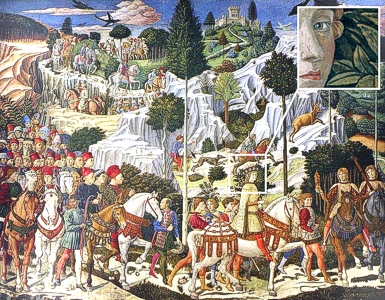 |
 |
 |
Casprini Da Omero Snc Passo dei Pecorai, 68/70 50027 - Greve in Chianti (Fi) Tel.+39.055.85.07.16/15 Web fax+39.055.71.88.114 Mob/Whap 3404536626 PI 03675100485 |
 |
The Palace of Cosimo il vecchio (senjor). For anyone who has already past and read the page of Pitti Palace already knows the competition between the Medici and Pitti on the size of the building and then dell'ostentazione of power between families Florentine time. Commissioned by Cosimo il vecchio, the palace Medici-Riccardi have resulted from the ingenuity of Michelozzo, having discarded a draft considered too showy for politicians, by Michelangelo. These statements are reported by Vasari that defines' too sumptuous and magnificent 'even if there are other findings in the affair. The fact is that all this could be real. Ten years earlier, Cosimo il vecchio suffered imprisonment in Palazzo Vecchio and a subsequent exile in Veneto on charges of tyranny by its opponents. It is true that shortly after he was ca lled a furor of people to return to the city but the caution, as they say, is never too much. Cosimo instruct Michelozzo, an architect equally valid but more discreet, who built a palace cubic apparent external impressive, but sober and austere (1444-1452 or 1460), around a central courtyard with Corinthian columns, inspired in part to the recovery of classical elements operated by Leon Battista Alberti in the implementation of Palazzo Rucellai. It was, however, precisely the Palazzo Medici to set charges throughout the civil architecture of the Renaissance, for example doing a model at Palazzo Strozzi. The palace, located in a strategic position at the cross between Via larga (now Via Cavour) and via de 'Gori. It was a stone's throw from the churches' protected by the florentine Familes: San Lorenzo and San Marco and many few steps from Duomo. The palace is impressive, sober and elegant, A stones hanging on the ground floor that with the rise of the plans, they become smooth and just framed the latest plans. On two sides, a bench away, in use very common in those days for convenience (allow people to sit down) and also for aesthetic reasons. The top floor, the current cornice was replaced by genuine battlements and a loggia which is currently walled. Inside the palace, among the numerous decorations, to report the chapel of the Magi, by Benozzo Gozzoli who was a pupil of Fra Angelico, Piero il Gottoso that directly followed the design and development work (1459). Indeed with the Magi, this painting has nothing to do with anything with religiosity. The most important people of the epoch had the right to be there, so they were represented on the paintings together Jesus or Mary or wathever! The painting there are inter alia: Lorenzo the Magnificent, his father, Piero Gottoso and the breadwinner, Cosimo il vecchio. The nativity on the altar is just a copy, the original is the museum in Berlin.
Enrichments. The interest in art and taste for beauty of the Medicis is manifested not only in careful choice of building, but also in the enrichment of that. Immediately sculptures, paintings and works of art of all kinds began to multiply. The David di Donatello, today dallal fame overshadowed that of Michelangelo, was in the palace garden. Now the statue is on the Bargello Museum (Palace of the Bargello) and the opening hours really ridiculous and the work of Buonarroti, David often 'forgotten'. Two huge mistakes. Inside the palace there were also three paintings of the 'Battle of San Romano' by Paolo Uccello hear that, hear and adorned the bedroom of Magnificent. There were also works by Botticelli, Verrocchio, Antonio del Pollaiolo, Domenico Ghirlandaio, collections of gems, cameos and vases in semiprecious stones. In the park on the North side, were placed statues classical bought largely in Rome and under the direction of Bertoldo, was created the first 'Academy of Fine Arts' where young and fans could copy, study and play models classic and learn artistic techniques of painting and sculpture. Leonardo da Vinci, was born artistically right here, not to forget Michelangelo and Raphael, the 'cursed painter '.
The sixteenth century. In 1492 died Lorenzo Il Magnifico and Florence ended an era. His son Piero, at the step of th Charles' VIII French army going to Rome, he had open the city gates not working hard battle. The subsequent sack of Rome was tremendous, the Romans promoted to fil sword, the city on fire, buildings and art works looted invaluable. Rome after the devastating passage, was never the same. The Savonarola then found fertile ground in preaching the values most Orthodox Christians. It was thus put in place the second expulsion of the Medici from Florence, the statue of Olofene seen in Piazza della Signoria a symbol of defeat of tyranny. The David donatello ended in Palazzo Vecchio while the property of the Church of Orsanmichele were made to enchantment. Fortunately the biggest part of the treasure never leaved Florence and the resumption of power, everything was recomposed by Cardinal John Medici (later Pope Leo X and son of Lorenzo - remember in this, regard also SS. Annunziata) and the Cardinal Giulio de 'Medici (later Pope Clement VII), the son of his brother Lorenzo (Giuliano murdered during the revolt of Pazzi). During this period was removed the loggia on the road to earn safely and open the large windows on the ground floor, work attributed to Michelangelo in 1517. Courtyard was placed sculpture dell'Orfeo of Baccio Bandinelli that is still admired today.

ADDRESS: |
Opening: Every day 09:00 -19:00 from 12 May to 31 August ... then like to the usual. boh! One looks at that the tourist and cultural season ends in this date! |